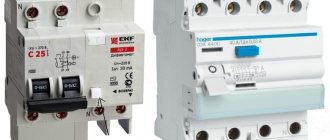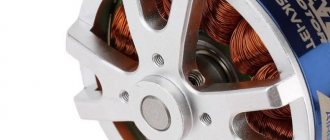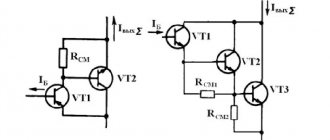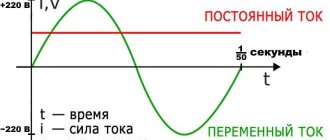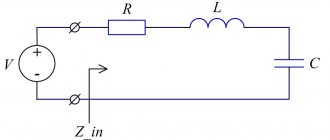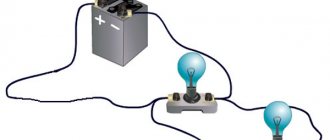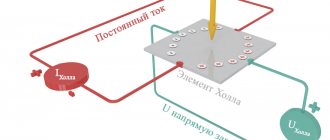Five main differences between RCD and difavtomat
For many people, the words difavtomat and RCD mean nothing.
But the time comes to replace the electrical wiring in the house or the construction of a summer house begins, and experts constantly mention them, the need for protection against electric shock, and offer different options. This is where the home owner needs to make a choice, and the right one. He wants to get reliable protection against electric current for reasonable money, without overpayment and unnecessary equipment. To do this, you need to understand a little about the devices, their purpose, differences, advantages and disadvantages. It will be useful for any novice electrician to understand what the difference is between different RCDs.
Purpose of residual current devices
The RCD protects the insulation of electrical wiring and prevents fire. And it protects a person from exposure to electric current when touching parts of devices that have phase voltage.
The RCD is triggered by an imbalance of currents in the phase and neutral wires of the protected electrical network. This happens when an insulation breakdown occurs and an additional leak appears.
Flowing current through unauthorized materials may result in a fire. In buildings with dilapidated electrical wiring, fires from damaged insulation occur quite often.
Another dangerous case is touching live parts of devices that should not be energized under normal conditions. The current begins to flow to the ground through the person, bypassing the neutral wire.
In this case, the circuit breaker will not work, since it requires currents of at least tens of amperes to turn off. Currents starting from 30 mA and above are dangerous to human life. The ability of the residual current device to respond to 10-30 mA is reliable protection against the effects of electricity.
You should know that an RCD does not provide protection against overcurrents; this is the main difference between an RCD and a difavtomat. In a situation where there is only an RCD and a short circuit occurs, the device will not react, and it may also burn out itself. It is not used separately, without a circuit breaker.
If the question is what to choose - an RCD or a difavtomat - you need to understand that together with the RCD you will definitely have to install a circuit breaker in the circuit.
Difference between VDT (RCD) and RCBO (Differential automatic machine)
How can one still distinguish an RCD from a difavtomat? What is the difference? In fact, these devices are designed to solve different problems, and therefore even an ordinary resident needs to know how they differ and what function they perform, at least in general terms. An RCD is often confused with a differential circuit breaker.
If you put an RCD and a breaker next to each other, their similarity will be immediately noticeable. But they perform completely different tasks. Let's remember what functions the RCD and the differential circuit breaker perform.
A residual current device (RCD) is triggered if a differential current—leakage current—appears in the network to which it is connected. When a leakage current occurs, the first person to be harmed is a person who touches damaged equipment. In addition, when a leakage current appears in the electrical wiring, the insulation will heat up, which can lead to fire.
Therefore, RCDs are installed to protect against electric shock, as well as damage to electrical wiring in the form of leaks that are accompanied by fire.
Differential automatic
is a unique device that combines both a circuit breaker (more understandable to the population as a “machine”) and the previously discussed RCD. Those. a differential circuit breaker can protect your wiring from short circuits and overloads, as well as from leaks associated with the previously described situations.
Visual difference
Determine which device is in front of you - an RCD or a differential device. automatic – quite easy even visually. Despite the external similarity (switch lever, the presence of a “Test” button, the same body part with a diagram printed on it, as well as numbers and letters), it is enough to look closely to see that the designations on these devices are different. It’s even easier to determine whether the RCD or the automatic circuit breaker is in front of you by the location of the “Test” button and switch. For RCBOs, the lever is located on the left, the button is on the right, but for RCDs it is the other way around.
Difference in labeling
On the surface of the RCD, the rated current is indicated exclusively by numbers. The Latin letter (B, C, D) in front of them is an integral feature of the RCBO. The body part of the RCD is marked “25A”. It means that the rated current in the circuit in which this device is connected should not exceed 25A. The RCBO is marked “C16”. The letter indicates the characteristics of the built-in releases.
Purpose of the differential machine
The difavtomat is used to protect the electrical network from overload, short circuit and leaks. In addition to the capabilities of an RCD, it performs the functions of a circuit breaker.
It happens that a person connects an extension cord with five or six additional sockets to one outlet, and connects several powerful devices through them. In such circumstances, overheating of the conductors is inevitable.
Or, let’s say, when the electric motor is turned on, the shaft jams, the winding begins to heat up, after some time a breakdown occurs, followed by a short circuit of the wires.
To avoid this, a difavtomat is installed. If the current excess is significant, then the difavtomat will turn off the line within a few seconds, without waiting for the insulation to melt, thereby preventing a fire.
The speed of switching off the automatic circuit breaker depends on how many times the flowing current exceeds the rated current for a given line. If the voltage is exceeded multiple times, up to a short circuit, the electromagnetic release is instantly triggered.
If the current flowing through the line exceeds the rated current by more than 25%, then after about an hour the device will turn off the line and the thermal release will operate.
If the excess is greater, the shutdown will occur much earlier. The response time can be determined from the time-current characteristics given for each device.
Appearance
General unification has led to the fact that it is very difficult to discern the difference between a difavtomat and an RCD based on the shape and size of the case.
For a single-phase network, the housings of these devices have a size equal to two housings of a single-pole circuit breaker. Each of them has a test button, they are two-pole. Installing an RCD on a DIN rail is no different from installing a difautomatic device.
Externally, differential circuit breakers differ from RCDs:
- according to the inscriptions on the front panel;
- labeling;
- functional diagram.
Usually at the top of the device below the name of the manufacturer is the name of the device. For example, VD and several numbers. VD means differential switch, that is, it is an RCD.
If the abbreviation RCBO is present (an abbreviation for the expression: residual current automatic switch), then it is a difavtomat. In case of damage to the inscription on the front panel, the manufacturer prudently embossed the name of the device on the side of the device.
True, to determine the type of device you will have to remove it from the DIN rail. But this method applies mainly to domestic manufacturers.
Foreign suppliers do not bother about this. Therefore, you have to navigate by markings and diagrams.
Rated current designation
The difference is observed in the designation of the rated current. In the RCD it is written as a number, for example 16 A, which means that the device will operate normally at currents not exceeding 16 amperes. The main characteristic for it is the value of the shutdown current.
For a difavtomat, in addition to the leakage shutdown current, the time-current characteristic is important. It determines at what overload currents and how quickly the device will turn off.
Therefore, before the rated current value there is a letter indicating the limit of exceeding the rated current at which the device will instantly operate. If there is an inscription on the front panel, for example, “C16”, then this means that this is a difavtomat.
Summary table of distinctive characteristics of modules
For simplicity and brevity, I have summarized all my information in a table comparing the characteristics of the protections under consideration.
| Module characteristics | RCD | Difavtomat |
| Purpose and tasks. | Protects only against leakage currents. It burns out during overloads and short circuits. | Protects against any currents: leaks, overloads or short circuits. |
| Rated current designation. | First, a digital expression is written from the standard series of the current scale, followed by the letter A. Example: 16 A. | First, a letter is written indicating the class of the time-current characteristics of the machine, and behind it is the rating number in amperes. Example: C 16. |
| Scheme on the case. | Only the differential organ is depicted. | The differential element, thermal release and cut-off electromagnet are shown. |
| Choice when purchasing. | It is necessary to additionally select the circuit breaker according to the operation setting. | Easier. |
| Place in the mounting panel. | More: requires more space to install the circuit breaker. | Less. |
| Installation conditions. | More complicated, additional connections are required. | Easier. |
| Technical name. | Differential switch | Automatic differential switch |
| Abbreviated designation. | VD | RCBO |
| Maintainability and replacement. | Cheaper. | Expensive. |
| Price. | Cheaper. | Expensive. |
For those who want to additionally watch a video on this topic, I recommend the work of the owner of “Electrician’s Notes.” Be sure to read the questions with comments below.
To what extent I was able to explain the difference between an RCD and a difavtomat in simple words is up to you to decide. Therefore, I look forward to your comments or questions on the topic.
Other differences
Already from the purpose of the devices it becomes clear what the difference is between them. The difavtomat is more universal; it includes RCD functions. But beyond the features and appearance, there are other differences.
Price
An important difference is the price. A differential circuit breaker is significantly more expensive than an RCD. Even if the RCD is functionally equal to that of a difavtomat by connecting an additional circuit breaker, the cost of the difavtomat will still be higher.
Dimensions and maintainability
The occupied volume of such a design due to the additional automatic machine will be one and a half times greater than the space for the automatic machine. This is important for small electrical panels.
But the maintainability of devices with equal functionality is better in the RCD+automatic system than in a simple automatic device. In addition, the reason for the shutdown immediately becomes clear - leakage currents or network overload.
Connection
But when installing a differential switch, you don’t have to think about how to install an RCD or connect it before or after the machine. In fact, most experts recommend installing the circuit breaker first, then the differential one.
As for the RCD, there are two options. If the RCD is installed on several groups of consumers, then it comes first, followed by circuit breakers for each group.
If one line is protected by one RCD and one machine, then the machine goes first.
Another point that needs to be taken into account when choosing between a differential circuit breaker and an RCD+ circuit breaker. This is the reliability of the devices. As you know, the simpler the device, the more reliable it is. In this regard, the difavtomat loses.
So, the main difference between a difavtomat and an RCD is their functions, markings, cost, connection method and space taken up in the panel.
What is best to use is decided by each owner independently. The main thing is to connect all devices correctly and provide reliable protection against fire or electric shock.
Connection
In the distribution panel, the RCD is connected together with a single-line circuit breaker (automatic) according to the proposed scheme:
Connection diagram for RCD and circuit breaker in the panel
In such a scheme, in the event of an electrical leak (for example, if the insulation in a washing machine is broken), the RCD is triggered, and if a short circuit or overload occurs, the machine is triggered. Several advantages of this connection:
- A separate device always performs functions better than a combined one, therefore a combination of RCD + automatic device will always work more reliably than a differential automatic device.
- Several circuit breakers can be connected to one RCD. For example, according to this scheme: In it, each of the machines will operate in the event of a short circuit or overload, and the RCD will operate if there is a leak in the network.
- When triggered, it is clear what caused the shutdown - overload/short or leak. Accordingly, finding the cause of the malfunction becomes much easier.
The difavtomat contains an automatic machine and an RCD in one housing. In this regard, it has only one advantage - it takes up less space in the panel, and even then, only if you decide to connect the entire room to one machine.
Which is better RCD + automatic or difavtomatic, let's look at the diagram
Let's consider a typical connection problem in an apartment. Kitchen connection:
- Circuit of sockets;
- Lighting circuit;
- Instantaneous water heater;
- Electric hob;
- Electric oven;
- Air conditioner.
For each of these circuits in the panel it is necessary to equip a separate machine. It is also necessary to protect the kitchen from leaks, because... This is a room where water is used and there is a possibility of flooding from above.
Let's calculate the spaces occupied on the DIN rail in the case of using RCDs + automatic circuit breakers:
RCD with automatic machines
Now let’s solve the same problem using differential automata:
Automats on rack
As can be seen from the diagram, in fact, in real conditions, a difavtomatic device takes up more space than an RCD + automatic device.
Automatic or differential automatic: how to distinguish and what to choose
In electrical networks, there is a constant possibility of some kind of malfunction, damage, or even an emergency. Various types of protective devices used in everyday life help reduce such risks. In this regard, many people are wondering what is better, more reliable and more efficient, an automatic or a differential automatic, how to distinguish and what to choose from existing devices?
It should be remembered that all circuit breakers, differential circuit breakers, and residual current devices serve to increase electrical safety for their intended purpose. They turn off electricity in emergency situations and prevent injury from electric current. These devices can be used in combination or separately, each of them has its own design features.
Electrical faults
The main function of all protective devices is to eliminate possible faults that periodically occur in electrical networks. First of all, they provide protection against short circuits caused by a decrease in the electrical resistance of loads to very low values. The main reason for this condition is the shunting of voltage circuits by metal objects.
Another common malfunction is related to overloading of wires under the influence of powerful modern electrical appliances. As a result, the appearance of large currents leads to increased heating of the wires, especially in low-quality networks. At the same time, overheating and aging of the insulation occurs, with the loss of its dielectric properties. In this regard, another type of fault occurs, known as leakage currents, arising from broken insulation.
Often the situation worsens further due to the use of old aluminum wiring, which is operated under critical conditions of constant increased loads. However, even new systems can malfunction due to poor installation and ineffective protective devices used inappropriately.
Mechanism of operation of circuit breakers
The machines are designed to protect against short circuits and overloads. For this purpose, they are equipped with a fast-acting electromagnetic trip coil and a system for extinguishing the electric arc that occurs during a short circuit. Overload in electrical circuits is eliminated using a thermal release with a bimetallic plate operating with a time delay.
The circuit breaker in residential buildings is switched on in the line of one phase wire. Only those currents that pass through it are controlled. The machine does not react at all to leakage currents. Thus, the functions of the circuit breaker are significantly limited. Additional protection is provided by a residual current device, which is connected in series with the circuit breaker.
What is the difference between a difavtomat and an RCD - which is better?
It is difficult for an ordinary person to understand how one sensor differs from another. They are similar in appearance, but differ in functionality.
RCD:
- It will react when there is an electricity leak in the electrical network that is connected to it.
- If this device is not in this position, a person may be injured when touching damaged equipment.
- In addition, a micro-leakage can lead to strong heating of the cable and further fire of household or industrial wiring.
- Therefore, such a sensor is needed in order to prevent electric shock, insulation overheating and fire.
Difavtomat:
- A universal device that incorporates all the functions of the above-described RCD and a circuit breaker.
- Prevents temporary short circuits, prevents micro-leakage of electric current, overload in electrical circuits that may occur at home or at work (offices, industrial premises, warehouses, and so on).
Many users, trying to check the operation of the RCD, deliberately create an overload by turning on many household appliances at the same time. In this case, the RCD will not work, and moreover, the network will catch fire along with this device. Therefore, the RCD must be connected together with the automatic circuit breaker. When working in the system, they will provide the necessary protection against such emergency situations.
Difavtomat and RCD
Visual differences:
- You might think they don't exist. Similar external equipment, the same plastic shell, the presence of the same buttons, switches, and so on.
- But look more closely and you will see that the letter signs are different, as are the toggle switches and schematic images.
Marking:
- The correct way to distinguish one sensor from another is by marking it by its rated current.
- On the plastic shell of these industrial devices the technical characteristics are indicated: indicators of electricity during leakage and operating overcurrent.
- If there are only 2 numbers on the top of the plastic, this is an RCD.
- If Latin letters are written on the plastic, it is a difavtomat.
Significance of electrical circuits:
- On any similar industrial device designed to protect against electric current, a schematic representation of all functions is printed on plastic.
- There is an oval on the RCD - this is the designation of a differential transformer device. It also shows an electromechanical relay, which opens and closes the electrical circuit.
- The same signs will be written on the automatic device as on the RCD, and you will also see a display of an electromagnetic and thermal release, whose functions include a response to short circuits and overloads in the electrical circuit.
From the schematic drawings printed on the plastic, you can easily determine which industrial device is in front of you - an RCD or a difavtomat.
RCD and difavtomat
Name and abbreviation:
- The inscription “Differential switch” will be visible on the plastic of the RCD. The abbreviation is “VD”.
- On the difavtomat - “Residual current circuit breaker”. The abbreviation is “AVDT”.
Quality of work and price:
- The difavtomat is cheaper than the RCD, since the latter consists of a set of the residual current device itself and the circuit breaker.
- In terms of quality indicators and operational reliability, the difavtomatic device and the RCD are not inferior to each other.
Exploitation:
- RCBO is a combined device. It has the disadvantage that when triggered, you will not be able to determine whether there has been a current leak or an overload.
- Therefore, the RCD is used in conjunction with a difavtomat.
- But now modern, improved models have appeared that have an indicator.
Repair:
- If the RCBO breaks down, you will have to completely replace the device.
- If the RCD works together with the automatic device, then if some part fails, only this working element is replaced.
Having decided on the differences, it is important to figure out which apartment wiring diagrams should be used. For example, for an ordinary apartment with several sockets and household appliances, an RCD and a difavtomat are suitable, which will work in one system
If you need to provide protection for a large country house with a utility room, boiler room, utility rooms, and so on, then it is better to install two RCDs and one automatic circuit breaker.
Differential machine device
The design of a differential circuit breaker is much more complex than that of a conventional circuit breaker or RCD. Its functions include eliminating all types of faults, including current leakage resulting from damaged insulation. The protection of the RCD built into the automatic circuit breaker is carried out using an electromagnetic and thermal release. All structural elements are enclosed in one module and located in a common housing.
Devices in a modern modular design are mounted on a special DIN rail. This allows you to significantly reduce the space required for their installation in the electrical panel. This is one of the main differences between a difavtomat and a conventional circuit breaker installed together with a residual current device.
What 2 dangers does an RCD protect against?
1st danger.
There are quite a lot of devices in our homes that operate on the network. Everyone knows that electric current is dangerous to humans. Under normal conditions, electricity does not pose a danger because... the housings of electrical appliances are insulated, and electric shock through the air is impossible. But there are two rooms in which current poses an increased danger. In the bathrooms there is a washing machine that has an electric motor and consumes significant power during operation. Also in the bathroom and kitchen, current flows through water. In this case (Fig. 1), a path for electricity through the human body is possible. Such a current, called leakage current (or differential), does not trip the circuit breaker in the panel, but is sufficient to cause severe electrical injury.
Rice. 1. If the phase wire (C) comes into contact with the washing machine body, there is a danger of electricity (red line) passing through the human body to ground (PE).
2nd danger
Current that flows uncontrollably from the electrical network leads to heating of conductive parts and can cause a fire.
The amount of electricity sufficient to cause injury and to cause a fire varies in magnitude. An RCD (fault protection) will help increase the safety of wiring by eliminating these 2 dangers. The differential protection has a fire-prevention effect when installed on groups of consumers (apartment or floor electrical panel). In other cases, the RCD is included in the power supply circuit of a specific consumer.
Definition.
A residual current device is a device used to protect people and electrical devices from differential current.
TOP 3 premises with mandatory installation of differential protection:
- Rooms with high humidity.
- With metal floors.
- Premises with devices having a conductive body.
Which protective device to choose
The differences between circuit breakers and differential circuit breakers must be taken into account when designing protective systems and electrical networks in general. Thus, it is possible to avoid a shortage of free space in existing electrical panels. The choice of a specific device is made in accordance with the tasks that will have to be solved during further operation.
Despite solving the same problems, the action of each device differs under the same conditions. For example, situations often arise when the total power of several devices can become greater than the rated protection value, which leads to a current overload. In this case, you will need to replace the installed automatic machine with a more powerful model. If an RCD is used, then it is quite possible to get by by replacing a cheaper circuit breaker.
A differential circuit breaker is best suited for protecting a separate electrical appliance connected to a dedicated line. The choice of device is carried out in accordance with the technical characteristics of the protected consumer.
When deciding whether to choose an automatic or differential automatic, you should take into account possible difficulties during installation work. There are no significant differences in the fastening system itself. They appear when connecting wires, since for a circuit breaker, in addition to phase and zero, additional jumpers will be required to make a serial connection to the phase wire together with the RCD. In certain situations, the assembly diagram can become significantly more complicated.
The high-quality, reliable and durable operation of each device is of great importance. These indicators are influenced by design features, number of parts and elements. In this regard, the differential machine is more complex and requires more settings for the operation of all parts and assemblies. The same goes for replacement and repair. Each device can fail and if repair is impossible, it is replaced. Purchasing a new differential circuit breaker is considered a more expensive process compared to replacing a conventional switch or RCD.
What is better to install in the panel: “difavtomat” or RCD?
Electrical wiring in a residential building is the most important element in providing power to devices and equipment. But you can’t do without protection in the electrical network. We will tell you the differences between an RCD and a differential circuit breaker and where they are best used.
In any case, it is impossible to do without protective elements of the electrical network in the apartment and in the country. These devices not only prevent serious consequences in the event of a short circuit and protect against exceeding permissible loads in the network, but also prevent current leakage. In most cases, circuit breakers, or “circuit breakers,” are used to protect devices from the consequences of a short circuit, while residual current devices (RCDs) are used to protect against possible leaks.
At the same time, both are well solved by combined devices, which have a mathematical name - differential circuit breakers, or “differential circuit breakers”. These are very convenient devices that combine two functions in one housing: an RCD and a circuit breaker.
What is the difference between an RCD and a differential circuit breaker and which is better to use?
One of the stages of installing a home electrical network is to install protective equipment.
It is mounted in the apartment electrical panel. In the event of increased load or failure, the device responds quickly to protect the entire system or a separate circuit. But before installation, you should find out what is the difference between an RCD and a differential circuit breaker in order to properly organize and secure your home network.
We suggest you understand the functional features of switching devices and find out in what situation what is best to use. In the article, we outlined the main criteria for choosing electrical protective devices, and also described the specifics of their connection and operation.
What to install: difavtomat or RCD
Below we will briefly describe what both devices are, and also find out whether an RCD or a difavtomat, which one to choose. For now, it’s better to dwell on the main parameters of choice, which often act as limitations. This includes the price of the device, the inconvenience of connection and, of course, the size of the panel where you will install the device.
But the main criterion is still the purpose: why this or that device is installed. In particular, to ensure the safety of one consumer and one line, feel free to take a difavtomat.
At the same time, you need to remember that you will need to provide quite a lot of space in the shield for additional protection. As you know, for an RCD it is also necessary to install a circuit breaker, because it does not have built-in overcurrent protection. It turns out that the machine requires one module-place, and the RCD requires three (the module itself is twice as thick). The same applies to connecting outgoing lines, the number of which also depends on the number of groups of sockets.
Currently, you can already find on sale single-module difautomatic devices, which in terms of their functions are identical to conventional RCBOs: they have both an RCD and an automatic circuit breaker.
But RCBOs have a peculiarity when connecting, because involves the use of additional and very expensive tools such as press pliers, strippers and other tools that will reduce installation time.
How to connect an RCD and a difavtomat
The assembly of these devices is carried out in a standard way: the phase wire is connected to the circuit breaker, and then leaves the machine and is connected to the upper “phase” terminal of the RCD. The neutral wire is connected directly to the upper “zero” terminal of the RCD. Then the phase and zero move from the lower terminals of the RCD to the consumer.
The connection diagram for the difavtomat is a little simpler: the phase and neutral wires are connected directly to the upper terminals of the device. From the lower terminals the power goes to the consumer.
Features of application
As you know, it is necessary to install a protective device in an electrical circuit precisely for the purpose of protection: as a result of a power surge or other emergency situations, it turns off the power using special technologies. As a result of such an operation, the technician will have to find the cause of the shutdown, which may include either a short circuit or a current leak. In the case of using RCBOs, such reasons may not be immediately detected.
But when using the “automatic device + RCD” combination, you will immediately see: if the RCD turns off, the fault lies in a current leak, but if the circuit breaker trips, then the reason is a short circuit or line overload.
What is an RCD
The RCD works as a human protector from electric shock and as a preventive mechanism to prevent accidental fire of wiring cables and connected cords of electrical appliances.
The functional idea of the device under consideration is based on the laws of electrical engineering, which postulate the equality of incoming and outgoing current in closed electrical circuits with active loads.
This means that the current flowing through the phase wire must be equal to the current flowing through the neutral wire - for single-phase current circuits with a two-wire wiring, and that the current in the neutral wire must be equal to the sum of the currents that flow in the phases for a three-phase four-wire circuit.
When in such a circuit, due to accidental human contact with non-insulated parts of the conductive elements of the circuit or when the exposed part of the wiring (due to damage) comes into contact with other conductive objects forming a new electrical circuit, a so-called current leakage occurs - the equality of the incoming and outgoing currents is violated .
This violation can be recorded and used as a command to shut down the entire electrical circuit. Based on this process, the RCD was designed. And the “leakage” current in the framework of electrical engineering began to be called differential current. An RCD can detect very small leakage currents and perform the functions of a switch mechanism.
When choosing an RCD, you need to remember that it does not provide internal protection against overcurrents; the RCD protects and reacts only to leakage current. Therefore, a circuit breaker must be installed in series with the residual current device. The rated current of the machine must be less than or equal to the rated current of the RCD.
What is the difference between an ouzo and a circuit breaker?
RCD (residual current device) or differential relay - provides protection against electric shock due to direct and indirect contact, as well as protection against fires that can result from failure of electrical wiring insulation.
A differential automatic device (diffavtomat) is a combined device, an RCD + an automatic device, which performs the functions of both an RCD (protects against electric shock) and a circuit breaker (protects against overload and short circuits)
The RCD differs from the diffavtomat by the inscription on the “panel”: for the RCD it is written “In 16A”, where 16A is the rated current, more than which cannot be passed through the RCD, and for the diffavtomat “B16” or “C16”, where “16V” or “16C” "is the rated current, above which it will be switched off due to overload.
What is the difference between an RCD or a diffautomatic device of type “AC” and type “A”?
RCD (diffautomatic) type “AS” - designed to detect leakage currents of only a sinusoidal nature.
RCD (diffautomatic) type “A” - designed to detect leakage currents of a sinusoidal, constant and pulsating nature.
The second type of device is more expensive due to its greater versatility. That is, if you have computers, photocopiers, or faxes in your office or home, it is better to choose a class “A” RCD. It is also better to install a type “A” RCD on the washing machine. In European countries, in accordance with the requirements of electrical standards, over the past few years there has been a widespread replacement of RCDs of type “AC” with type “A”.
How to distinguish an RCD from a difavtomat visually
Everything here is quite simple, although the two devices are very similar to each other. First of all, on the front side of the RCD you can see a powerful switch, an indicator and a “Test” button. Secondly, on the RCD on the body the current marking is indicated in large numbers, for example, 16A.
If at the beginning of the inscription there are the Latin letters B, C or D, and then there is a number, then this is a differential machine. For example, the current strength 16 is preceded by the letter “C”, which means the type of characteristic of the electromagnetic and thermal releases.
The difference in appearance between an RCD and a differential circuit breaker
Determine which device is in front of you - an RCD or a differential device. automatic – quite easy even visually. Despite the external similarity (switch lever, the presence of a “Test” button, the same body part with a diagram printed on it, as well as numbers and letters), it is enough to look closely to see that the designations on these devices are different. We'll talk about this below. It’s even easier to determine whether the RCD or the automatic circuit breaker is in front of you by the location of the “Test” button and switch. For RCBOs, the lever is located on the left, the button is on the right, but for RCDs it is the other way around. This can be clearly seen in the above photograph.
When the RCD does not protect
The RCD will not react when a person or animal comes under voltage, but no ground fault current will occur. This case is possible when touching simultaneously the phase and neutral conductors, which are under the control of an RCD, or when completely insulated with the floor. RCD protection in such cases is completely absent. An RCD cannot distinguish the electric current passing through the body of a person or animal from the current flowing in the load element. In such cases, safety can be ensured by mechanical protection measures (full insulation, dielectric casings, etc.) or complete de-energization of the electrical device before its technical inspection.
Therefore, the RCD is always connected in series with the machine. These two devices work in pairs: one protects against leaks, the other against overloads and short circuits.
The difference between an ouzo and a differential machine according to its functional purpose
If you look at the RCD and the difavtomat, then in appearance these two devices are very similar to each other, but the functions they perform are different. Let's remember what functions the RCD and the differential circuit breaker perform.
The residual current device is triggered if a differential current—leakage current—appears in the network to which it is connected. When a leakage current occurs, the first person to be harmed is a person who touches damaged equipment. In addition, when a leakage current appears in the electrical wiring, the insulation will heat up, which can lead to ignition and fire.
Therefore, RCDs are installed to protect against electric shock, as well as damage to electrical wiring in the form of leaks that are accompanied by fire. For more details on how this device works, see the article on the principle of operation of an RCD.
Now let's look at the differential machine. This is a unique device that combines both a circuit breaker (more understandable to the population as a “machine”) and the previously discussed RCD. Those. a differential circuit breaker can protect your wiring from short circuits and overloads, as well as from leaks associated with the previously described situations.
Now the main point where everyone starts to get confused: remember that the RCD, unlike the automatic circuit breaker, does not protect the network from overload and short circuit. And most consumers think that by installing an RCD, they are protected from everything!
In simple terms, an RCD is simply an indicator that monitors leakage and that current does not flow past your main consumers: electrical appliances, light bulbs, etc. If somewhere in the network the insulation is damaged and a leakage current appears, the RCD reacts to this and turns off the network.
If you turn on all electrical appliances (heaters, hair dryers, irons) at the same time, that is, deliberately create an overload, the RCD will not work. And the wiring, if there are no other protection devices, rest assured, will burn out along with the RCD. If, when the RCD is turned on, you connect phase and zero and get a huge short circuit, then the RCD will also not work.
Why do I mean all this, I just want to draw your attention to the fact that since the RCD does not protect the network from overloads and short circuits, you will probably agree with me that it itself needs to be protected. That is why the RCD is always connected in series with the machine. These two devices work in pairs, so to speak: one protects against leaks, the other against overloads and short circuits.
By using a difavtomat instead of an RCD, you get rid of the situations described above: it will protect against everything.
| Let's summarize, the main difference between an RCD and a difavtomat is that the RCD does not protect the network from overloads and short circuits. |
